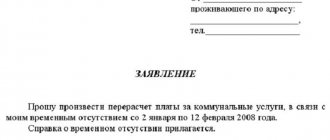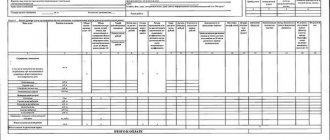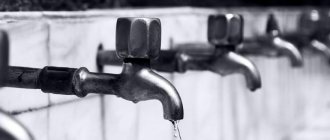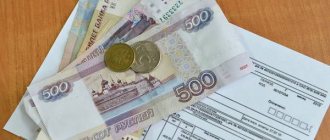How to avoid paying for sewerage
Payment for sewerage is mandatory for all citizens living in Russia, and cancellation is not provided.
However, on April 16, 2013, the Government of the Russian Federation issued Resolution No. 344, according to which the determination of the standard for wastewater disposal for general house needs is canceled. Consequently, now the payment for the removal of water for public use should not be included in the receipt (unless otherwise specified in the agreement with the water utility or management company).
Otherwise, consumers have the right to file a lawsuit against the violators and demand a recalculation, taking the volume of consumption according to the meter as a basis.
Cold water supply and hot water supply in the receipt: what is it
The rules for providing utility resources to individual apartments and houses (regardless of the form of ownership, as well as the intended use of the premises) are outlined in the articles of the Housing Code of the Russian Federation. Thus, the document establishes that payments from citizens must be received on time and in full. Violation of the deadlines for transferring money, as well as lack of payments, is the reason for the application of sanctions.
Lack of payment for sewerage and other services in an apartment building may cause a temporary shutdown of services.
The Housing Code also determines the rules for generating payment documents. There may be several receipts or just one document. To create a universal form of payment, universal abbreviations are used. These are abbreviations used by all management companies, as well as various service providers. In particular, the following abbreviations must be taken into account:
- DHW – supply of hot water to residential premises;
- Cold water supply - cold water supply.
As for hot water, it is not provided to all users, but is drawn up in accordance with personal contracts or in accordance with the agreement of the management company. Cold water supply is available to all citizens who pay for the resources on time. Next to the HVS column there is an additional abbreviation:
- KPU - a person’s apartment has an individual meter, and therefore payment is made personally, depending on the services consumed;
- DPU - the total water consumption of the entire house is calculated, and then the indicators are divided equally among all apartments.
Receipt with an error in favor of the consumer
The consumer may receive receipts with reduced rates if the management company did not take into account one or more residents registered in the apartment. In this case, the receipt will indicate the amount calculated based on the old number of registered residents in the apartment.
An error in the number of registered residents will result in growing debt. In fact, unregistered residents will also use the services, so the accumulated debt will in any case fall on the shoulders of the homeowner.
Sooner or later the error will come to light. The Management Company will establish the fact of an error in the number of registered residents, and then demand compensation for losses from the owner of the property.
The management company has the right to demand payment of the accumulated debt only for the past 3 years.
This means that a homeowner who pays utilities without taking into account one of the registered residents for 5 years is obliged to pay the resulting debt for only 3 years. Accordingly, the management company is obliged to calculate the debt only for 3 years, leaving the remaining 2 years without attention.
If the management company does not agree with this provision, the user has the right to go to court.
Rate this post
Abbreviations on utility bills
Modern utility services do not have a single standard payment designation. At the same time, the receipt contains abbreviations that are not always clear.
Below is a breakdown of the abbreviations used in receipts:
- HVS DPU. This value indicates cold water supply. At the same time, the DPU is a household metering device. Accounting is carried out according to the data of the general building meter.
- HVS KPU. This value is included in the receipt if cold water supply is calculated using an apartment metering device (KPU).
- DHW DPU. The service means hot water supply, here the house meter is used for charging.
- Drainage It is a service in which waste water is removed.
- Opl. lived This value represents payment for housing.
- Lived izl. pl. Characterizes payment for apartment area (based on surplus).
- Heating basic pl., as well as payment. izl. pl. The first value means the cost of heating the main apartment area, and the second is the payment for heating the excess area.
You can pay for utilities via the Internet
In addition to the above breakdowns of utilities, the payment receipt includes charges for electricity and major repairs (maintenance and repair). Each receipt must contain the type of utility service and the fee for its use.
How to pay for sewerage
Like any other utility services, you must pay a fee per calendar month for sewerage to your apartment. The payment deadlines are quite clear. At the end of the reporting period, a receipt is sent to the consumer, indicating the amount due. Rent must be paid by the 20th day of the month following the reporting month.
Otherwise, defaulters who owe money will be subject to penalties in the form of a fine for each day of late payment. Delaying payment will entail consequences, since the water utility will consider that its interests have been violated.
What do we pay for?
There is no division in payments for utility services, therefore the total amount is calculated for the consumption of resources and for services, as stated in the “Rules for the provision of housing and communal services for owners and users of premises.” The meaning of the decree is this: even if your apartment does not consume one of the resources, if you turn it off, you will still have to pay. Example: there is no installation of an individual gas meter for a neighbor, but the house is supplied with gas, you pay not only for yourself, but also for your neighbor.
And although consumption shows the same amount of one resource (as much comes in, the same goes out), tariffs for sewerage and water supply are calculated differently
In this case, it does not matter at all that the user does not drain all the incoming water into the sewer; some goes for watering plants, some for drinking, etc. However, with all the seeming injustices of the housing and public utilities sector, we should not forget that the used flows are necessarily sent to treatment facilities, where deep biological treatment is carried out and the user also pays for this
What does the “water disposal” item on the receipt mean?
The line “Water disposal” in the receipt is the payment for water removed from the residential premises. In fact, a person pays to have already used water removed from his apartment. The dirty liquid is collected, then delivered to treatment facilities and passed through a filter system.
Many users believe that this service should be included in the water supply, but this is not the case. Water supply includes services such as:
- transportation of water through a pipeline to the apartment building and maintenance of utility networks;
- carrying out disinfection and supplying cold water;
- heating and supply of hot water.
Many people believe that sewerage and sewerage are one and the same thing, which means that the appearance of such a column on a receipt is illegal. In fact, these two systems are significantly different because the drainage removes sewage and wastewater from the house, and then it is treated, and then it is collected in the sewer system. The fee is charged specifically for the purification of already used water.
Formation of tariff for drainage
The tariff for water disposal is subject to separate determination in each region, which is carried out by a special authorized body.
- The parameters for calculation are the following indicators:
Climatic features of each specific area. Condition of sewer networks. Condition of water supply networks. Distance for pumping water and waste. Condition and quality of pumping station equipment. The number of citizens consuming this service. Payment for the work of emergency crews responsible for maintaining the condition of the network. Ensuring and monitoring the performance of automated control systems. Payment to water utility workers.
- As an example, several tariffs for wastewater disposal:
Rostov region — 24.26 rubles/cubic meter Moscow region — 23.43 rubles/cubic meter Surgut — 25.44 rubles/cubic meter
Deliberate drainage of water
Housing and communal services have the right to demand payment for intentional drainage of water only in a situation where it was made by the owner of the premises, or the noted situation occurred due to leaks and improper condition of the system in the apartment. Note that it is worth draining the water periodically, but the issue of payment remains open.
According to current standards, owners are obliged to monitor the integrity and safety of their property, and if it is determined that the drain occurred due to the owner’s negligence, he will pay. But if the sewage system is new, and everything is in order in the apartment, then the housing and communal services will pay for the intentional drainage.
If there is a deliberate drain of water by housing and communal services employees, consumers will not pay for it. If the payment slip indicates otherwise, that is, there is an unlawful charge of payment, they have the right to contact law enforcement officers with a complaint against the utility companies.
Tariffing or self-payment
Calculating the receipt column is quite simple: water disposal is equal to the sum of hot water and cold water multiplied by the tariff. For example, the supply of water flows is 20 m3, the tariff is 20 rubles, the total amount is 400 rubles. However, if the payment line shows a total receipt of 20 m3, and a total drainage of 25 m3, this is unacceptable; there is a common deception of public utilities, which can be challenged in court.
Apartment buildings often have a common building meter, which shows the amount of payments, but if it does not exist, the calculation is issued by the housing and communal services through the service provider company. If necessary, you can always install your own meter by first submitting an application for installation of the device. As soon as the permit is issued, the meter is installed, sealed and the amounts due for payment are recalculated. Look at the photo to see what the counter looks like.
What is KPU? This question is often asked by users. KPU is a collective metering device installed in a common household manner. In other words, KPU is a counter that shows how much sewage has been drained over a given period of time. However, the abbreviation KPU is not in any official document; in the lines and columns there is “Common house or common house. utility metering devices." It turns out that the KPU is an invention of the housing and communal services sector and nothing more, especially since the use of abbreviated names of devices in official documents is not allowed unless specified by the rules or an addition to the resolution.
So, the fee calculated for sewerage can be checked independently, and in case of the slightest violations when issuing payments for utility services, you can go to court with the housing and communal services. If there is no meter, the amount is calculated according to standard standards established annually. You can find out the standards either from the management company or on the website of the administration of the city or locality.
And, most importantly: Decree of the Government of the Russian Federation dated April 16, 2013 No. 344, payment for housing and communal services for wastewater consumption has been cancelled. Cancellation date: 06/01/2013. The document “On Amendments to Certain Acts of the Government of the Russian Federation on the Provision of Public Utilities,” therefore, if your housing and communal services do not know about this, it would be useful to remind them of this by attaching a photo or copy of the document.
The article was written based on materials from the sites: domdomoff.ru, fb.ru, realtyinfo.online, 1kvartirka.ru, vodakanazer.ru.
How to calculate the cost of a service
How many cubic meters of water a tenant uses in a month is how much he must pay. If ten cubic meters of cold water were used, then the indicator that is in the “Tariff” column must be multiplied by 10. The same with hot water. But how is the calculation for sewerage done?
Both cold and hot water are recycled. When calculating, you should multiply the tariff (sewage) by the total number of cubic meters consumed. That is, if eight cubic meters of cold water and four hot ones are used in a month, you should find the derivative from the numbers 12 and x. X is a tariff, which, as already mentioned, can be different. But in most cases it ranges from 20 to 25 rubles.
Payment for sewerage is divided by the number of residents if a common building meter is installed. Installing an individual one can significantly reduce the total amount on the receipt.
Value and cost calculation of HVS KPU
Starting from 2012 in the Russian Federation, all apartments must have special control units responsible for accounting for water in housing. This means that when calculating charges for cold water supply in premises of any type, the readings of the installed device are taken into account.
All receipts should be kept
Moreover, such equipment can be shared (apartment) or individual.
You can calculate cold water in an apartment using formula No. 1 (point 42 of the new rules):
- The number of cubic meters of cold water consumed during the billing period is determined (usually considered a calendar month);
- The resulting number of cubic meters of cold water is multiplied by the established tariff, after which payment for the service is made.
If the apartment does not have an individual or apartment metering device for cold water, in order to determine the tariff for calculating the cost of the service, it is customary to use formula No. 4 (point 42 of the new rules):
- The number of residents living in the apartment is taken into account;
- For each region, a standard for cold water consumption per resident during the billing period has been determined;
- Payments (receipts) indicate the product of these two values.
Through the cold water service, consumers have the opportunity to receive cold drinking water in the required quantities around the clock.
Water disposal in utility bills
Many citizens of the Russian Federation do not fully understand the concept of “sewage” and, even more so, they do not understand what sewerage is in utility bills.
It seems to them that they are paying for the same thing twice, and the second time it is even more expensive. Actually this is not true.
Video: payment for housing and communal services
Used water does not just go down the drains of our sinks and bathtubs somewhere underground and get lost there.
Water disposal includes the following technological stages:
- Wastewater disposal.
- Transportation to wastewater treatment plants.
- Cleaning.
- Disposal or use for technical purposes.
Thus, it is clear that drainage is a complex process that requires serious labor and financial costs.
All these costs are included in the tariffs for sewer services.
What it is?
Many people confuse the similar names of utilities and “sewage”.
In both cases, the main “character” is water, but in completely different forms:
Since the main cost of the sewerage service consists of the subsequent stages of cleaning and disposal, the obligation to pay is assigned to absolutely all city residents living both in apartment buildings and in the private sector.
The exception is frequent residential buildings that are not connected to the general sewer system.
Calculation examples
Calculating how much you will have to pay for sewer services is quite simple.
The main thing is that water meters are installed in the house.
These can be either individual hot and cold water meters or communal meters.
Based on the readings for the reporting period, it is necessary to add up the consumption of hot and cold water.
The resulting amount is multiplied by the sewerage tariff and the amount payable for sewerage services is obtained.
For example, a user used 25 cubic meters per month. hot and 43 cubic meters of cold water. The tariff for sewerage services is 9.42 rubles per 1 cubic meter. We get the expression - (25+43)*9.42=649.54 rubles.
The calculation rules are established and approved by the Decree of the Government of the Russian Federation “On the procedure and conditions for citizens to pay for housing and utilities.”
Tariffs in individual regions and constituent entities of the Russian Federation are set by local authorities.
Their value is significantly influenced by the condition of citywide sewer systems, as well as the availability of modern treatment plants and recycling equipment.
If you don't have a meter?
Sewage services are not cheap, and those consumers whose apartments or houses do not have metering devices are not at all to be envied.
In the absence of meters for hot and cold water supply, monthly consumption is calculated based on general standards.
As is known, average consumption rates do not correspond to the actual volumes of water consumption; they are much higher.
In the absence of metering devices, the cost of monthly wastewater disposal costs is calculated as follows:
Grounds and procedure for calculating payment
The Government of the Russian Federation sets standards for payment of utility services. Drainage was no exception.
The rules for setting tariffs for the provision of utility services were approved by Decree of the Government of the Russian Federation No. 394 “On the procedure and conditions for citizens to pay for housing and utilities” dated July 30, 2004.
Please note! Regional authorities have the right to adopt other regulations that reduce or increase the cost of providing services.
In the Russian Federation there is no single tariff that is used to provide water disposal and sewerage cleaning services.
There are several important nuances that directly affect the setting of tariffs in a particular region, city, house, apartment:
- equipping the apartment with special meters,
- the region of location of the apartment for which the receipt for payment for the service is received,
- decisions of local governments on setting maximum tariffs and establishing benefits for certain categories of citizens,
- application of benefits.
If the house is under the control of a management company, then its percentage of service provision is taken into account when determining tariffs.
Sewage is the collection and disposal of waste, and sewerage is the disposal of water by the company that supplies it.
To do this you should consider:
- volume of liquid waste,
- total mass of wastewater,
- other indicators that are taken into account when determining the cost of the service.
You can save on water disposal if you use the volume of incoming water rationally. For example, turn off the tap on time, change the gasket, adjust the plumbing, and the like.
How to refuse KPU maintenance
and all sanctions will actually begin from this year, because the absence of a certificate of timely verification is equated to the absence of a meter as such, accordingly the Criminal Code will begin to charge at the current tariff, this time, but here the Jewish nature of some residents is very often included: and There are two people registered with me, but four people live, it’s more profitable for me without meters, and this case is now provided for: starting this year, increasing coefficients are being introduced to calculate the cost of water in apartments that are not equipped with water meters https://www.rg.ru/201. /schetchik.html.
Moscow Government Decree No. 344 dated April 16, 2013 was issued. , according to which from January 1, 2015. increasing coefficients will be applied to the standard for those who did not voluntarily install meters. Also, increasing coefficients will be applied to those who did not check on time, who did not replace a broken meter, this may also apply to those who did not allow the inspector into the apartment.
Rules for calculating consumed resources
If you are interested in the question of how to calculate drainage, you must be guided by the following rules:
- In accordance with the thirteenth paragraph of Government Decree of the Russian Federation No. 392 of July 30, 2004, to determine the amount of payment, an established formula is used, where the tariff for sewerage adopted in the region is multiplied by the size of the resource consumed;
If there are installed individual meters for hot and cold water in the apartment, their indicators are used in the formula; when calculating per person without a meter, the average indicators adopted by local governments are used;- If sewerage meters are available, the number of cubic meters of hot water is multiplied by the regional tariff, taking into account VAT, after which the number of cubic meters of cold water is multiplied by the same tariff and these two results are summed up, which is the amount payable;
- In the absence of meters for metering resource consumption, standard standards for the locality are applied, regardless of how much the consumer actually uses and whether he uses it at all;
- Current standards are reviewed annually and published on the official websites of local administrations, as well as in local media;
- When it comes to an apartment building, common house meters are taken into account, if any.
What do abbreviations mean on rent receipts?
If there are few lines, the purpose of payments is not disclosed in detail - this is the first reason for suspicion. Typically, the management company deliberately does not disclose the purpose of payments
It is worth paying attention to the total amount: if it differs from what it was a month earlier, it is better to carefully check the entire account. At the same time, after the tariff increase, we remind you that they were raised on July 1, the account should be checked especially carefully
Management companies and utility suppliers can inflate bills under the guise of a planned increase.
The payment usually consists of a number of mysterious abbreviations, and each region may introduce its own abbreviations. There are several generally accepted ones: If the KPU is indicated, it means that you pay for water using your apartment meter.
That is, the cold water that goes for heating is given in another line the price for the heating itself. By adding them up, you get the final price of hot water. These are services provided by an apartment building management company for the maintenance and ongoing repairs of common property in an apartment building. That is, if you have this line, it is assumed that order is maintained in your entrance and everything is working. This line may include various services: maintenance of in-house engineering equipment, cleaning, routine repairs, garbage removal, concierge services, etc.
In this case, the amount and services included in the receipt must be approved by the decision of the residents themselves at the meeting. There are also services that citizens do not actually use: for example, paying for an antenna and radio point. They can be waived individually by contacting the Criminal Code with a request to exclude these items from the general account. Amounts for individual consumption of utilities used in the apartment and for general house needs of one; for example, expenses for heating and lighting of the entrance in the payment slip should be posted in different columns.
There are cases when the amount of payment for the use of utilities per person per person exceeded the amount of individual consumption in apartments. This can happen when payments to ODN are calculated not according to meters, but according to standards with an increasing coefficient due to the lack of a meter. To reduce costs, owners must vote at a meeting to install meters. They are installed by resource supply organizations. You should check whether the area of the apartment is indicated correctly on the payment slip.
Heating and payments for major repairs are calculated on a per square meter basis. Regional authorities provide subsidies that compensate for part of the payments, but they operate only within the social norm in Moscow, which is 33 square meters. You will have to pay for housing surpluses. Also, do not rush to register new residents. The more people there are, the more expensive it will be, for example, for water if meters are not installed.
If one of those registered in the apartment does not live in it for a long time, then a recalculation can be achieved. You just need to prove your absence - for example, bring a certificate from the management company from your real place of residence.
The same applies to summer residence at the dacha and long business trips: if the appropriate documents are available, the management company is obliged to recalculate. Calculating how much you should pay for a new service is simple. In Moscow, the monthly fee is 15 rubles. The new line appeared in the capital in July and has already caused a wave of discontent.
However, so far the practice is not in favor of residents. In this case, you must contact the regional department of housing subsidies, presenting a certificate of income and a certificate of ownership. At the same time, there should be no excess living space: the established standards are 33 square meters. If it turns out that the bill is inflated, you need to file a complaint with the management company.
Tariff calculation in an apartment building
Payment for sewerage is made taking into account the indicators of water used. The volume of water spent is taken into account.
The funds from this payment are used by the utility to arrange the transportation of the waste liquid to special treatment facilities.
This indicator is calculated very simply: hot water supply (hot water supply + hot water supply) is multiplied by the established tariff. This formula is provided for by law, so even if the resulting amount is large, you cannot avoid paying for drainage services.
Features of drainage in the house:
- In an apartment building, it is customary to use common building equipment for accounting. It is based on the indicators of such a device that the drainage fee is calculated.
- If there is no communal equipment, the utility company will be billed for this service.
- Some owners install their own meter in the apartment. Before installing such a device, you must submit an application. Only after obtaining permission is the device mounted and sealed.
In order not to pay for extra cubic meters, it is recommended to pay attention to information about the amount of hot and cold water used. If the sum of these values in the payment slip is less than the indicator indicated in the “sewage” column, you should file a complaint with the court.
Receipt with an error in favor of the management company
The main reason for inflating utility bills is to write off other people's debts at your expense. The management company charges additional amounts to taxpayers in order to reduce the amount of the principal debt on utility bills. They rely on the fact that most ordinary citizens pay their rent automatically, without thinking or checking their payment receipts.
Prevention in the fight against inflated utility bills is a careful check of each receipt for errors.
The best way to identify errors is to compare old receipts with new ones.
If you find errors in receipts or the presence of non-existent services, you must contact the management company with a written request to recalculate utility bills.
You can request a recalculation of a receipt on the following grounds:
- Inflated housing and communal services tariffs;
- Payment of non-existent workers;
- Payment for non-existent services;
- If the services indicated in the receipt were not actually performed by the management company.
As practice shows, in order to avoid litigation, management companies meet service users halfway and recalculate.
Individual meters installed for hot and cold water consumption will help reduce the risk of overpaying for housing and communal services. In this case, the service user will pay utilities only for the amount of water that he actually used. In houses that do not have individual water meters, utility bills are calculated based on average indicators, which gives Management Companies a reason to charge extra cubic meters of water.
How to calculate correctly
Wastewater disposal is the collection and disposal of wastewater. Moreover, all their types are taken into account here. The exact amount to be paid cannot be determined. However, you can roughly calculate how much you will have to pay for sewerage this month.
Remember! The following formula is used for this:
Cost of sanitation service = (HW + HW + CO) * T, where HW is the volume of hot water consumed, HW is the total volume of cold water consumed, CO is the connection of wastewater, T is the tariff for service in a specific region.
However, if the volumes of cold and hot water can be determined from the readings of a special meter, then the volume of connected waste cannot be determined. Counters are not installed here. Not so long ago, manufacturers began to produce metering devices that are capable of operating in unsuitable conditions. But management companies and utility services are in no hurry to implement them, as this requires a lot of costs.
Thus, if you know how much hot and cold water you consumed per month, then add ten percent to this amount, you will get an average figure.
Watch the video. General house drainage:
Water drainage on the receipt: what is it and what does it come with?
Knowing how to calculate drainage, the consumer can accurately pay the required amount. The case with apartment buildings has an interesting nuance: if there is no common building meter, then the housing and communal services make payments through communication with the company that supplies a specific service. Currently, the popularity of individual meters has sharply increased for a simple reason: the device is located by the owner of the premises, which makes the task easier: finding out the drainage system. To better understand the calculation procedure, an example should be given to show what the calculation operation looks like.
It follows that water supply and sanitation are different categories, contrary to popular belief that they are the same thing. It should be noted that water supply is more expensive than its “brother” - this is due to the fact that water supply also includes the actions of heating and cooling water.
What is sewerage in a housing and communal services receipt?
According to the majority of Russians, payment for sewerage means payment only for sewerage, that is, exclusively for water flow. Partially, this assumption can be considered correct. But in addition to draining water, this service includes drainage, disposal, transportation and further purification of consumed water.
As for drainage, it consists of removing used water. Simply put, water disposal is the purification of already used water and its further disposal through sewerage. This housing and communal services service is mandatory for payment by all residents of the city: from apartment owners to owners of private houses.
What is drainage in utility bills and how is it calculated?
Since 2012, another line has appeared in receipts for utility bills - “Water disposal.” In a simplified sense, this means the discharge of water used by apartment residents into the sewer system.
The contractor with whom the municipality, management companies, cooperatives or private individuals have entered into an agreement for the provision of utility services is responsible for the smooth functioning of the process.
In many localities this is a unitary enterprise (or JSC, OJSC) Vodokanal. And all owners of apartment buildings and private houses connected to the general sewer system pay for sewerage costs.
Is it legal to pay for water heating using a receipt in 2018?
If the legality of the additional line “water heating” in receipts is in question, in order not to overpay for heating, it is recommended to first contact the Criminal Code with a request to explain what this item means. The appearance of a new line in the receipt is legal only on the basis of the decision of the owner of the apartment building premises. In the absence of such a decision, you should write a complaint to the State Housing Inspectorate. After filing a complaint with the Criminal Code, you must be provided with an answer with explanations within thirty days. If you refuse to justify why such a service is indicated in the receipt, you should file a complaint with the prosecutor's office with a claim in court. In this case, if you have already paid the amount indicated in the receipt, the basis for the claim will be Article 395 of the Civil Code of the Russian Federation. If a refund is not required, but you must pay for services that are not provided to you, file a claim to exclude the “water heating” line. In this case, it is worth referring to Article 16 of the Law “On Protection of Consumer Rights”.
Regulatory regulation
What is drainage in utility bills is explained by Federal Law No. 416 of December 7, 2011. It replaced numerous disparate federal and local laws. Some of them continue to operate, setting, for example, tariffs and requirements for the quality of water supplied to apartments and then discharged into natural reservoirs.
Federal Law No. 416 describes:
- powers of central, regional and local authorities in the field of wastewater disposal;
- methods for ensuring and checking water quality, its compliance with environmental standards;
- drainage procedure;
- tariff regulation rules, etc.
Sewage as one of the public services is also affected by the Housing Code of the Russian Federation in Section VII. The Code establishes, in particular, the obligation of citizens - residents and owners of premises - to pay for the receipt and disposal of used resources. It describes the calculation procedure and sanctions for the occurrence of debt for housing and communal services.
Decree of the Government of Russia No. 354 of 05/06/2011 supplements Law No. 416 and the Housing Code of the Russian Federation with the rules for the provision of housing and communal services and the procedure for calculating fees for them. It provides formulas by which any citizen can check whether there are any errors in the housing and communal services receipt.
Resolution No. 306 of May 23, 2006 determines the methods and procedure for setting standards for cold and hot water supply (and, accordingly, sewerage) if the house is not equipped with apartment-by-apartment metering devices. Their values are set by regional authorities and published publicly on the websites of departments or management companies.
How to view water meter readings?
It is very important to provide correct data when transmitting readings from a water meter. If correctness is violated, the user will have to pay a penalty. Due to the fact that there is no uniform requirement for the modification of water meters, meters of different models can be installed in houses. Requirements for taking readings will depend on what model a particular apartment is equipped with.
Old-style devices are induction type meters. When taking data from these metering devices, you must follow the following rules:
- Indicators must be taken monthly on the same date;
- to get the correct value of water consumption, you need to subtract the previous ones (for the last month) from the new data;
- record current data to use for calculations next month.






